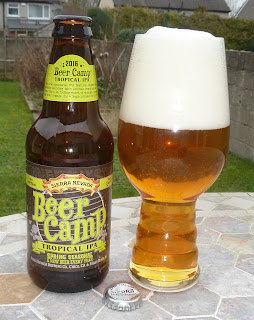 Ryklio Kavinukas ("Shark's Coffee Pot") is a coffee milk stout at 4.5% ABV. It looks typically stouty, though perhaps a little more brown than proper black. I think I was expecting something of a confection: sweet and highly coffee'd, but it's not. Instead, this is a very straightforward medium strength stout, not that different to any mainstream bottled Irish one. There's a light roast and a mild sweet-sour tang which I'm guessing is the lactose at work but neither comes on particularly strongly. A low carbonation level makes it nicely drinkable which means I made short work of the bottle. In a different mood I might feel gypped by its lack of bells and whistles, but I enjoyed its simplicity. Inoffensive doesn't have to mean bad.
Ryklio Kavinukas ("Shark's Coffee Pot") is a coffee milk stout at 4.5% ABV. It looks typically stouty, though perhaps a little more brown than proper black. I think I was expecting something of a confection: sweet and highly coffee'd, but it's not. Instead, this is a very straightforward medium strength stout, not that different to any mainstream bottled Irish one. There's a light roast and a mild sweet-sour tang which I'm guessing is the lactose at work but neither comes on particularly strongly. A low carbonation level makes it nicely drinkable which means I made short work of the bottle. In a different mood I might feel gypped by its lack of bells and whistles, but I enjoyed its simplicity. Inoffensive doesn't have to mean bad. A dubbel to follow, though a light one at just 6% ABV. Nežinomas Krantas ("Unknown Shore") is a chestnut maroon colour with a short-lived ivory head. It smells rich and estery with a touch of dark rum about it. It is light of texture and the finish is quick so falls short of the dubbel spec there, but it is tasty. A luxurious plum pudding and port booziness, rum and raisin ice cream, almost but not quite tipping over into marker pen and model glue, probably from an unnecessary addition of oak chips. It's perhaps not as refined as the typical Belgian dubbel, at least partly down to a lack of yeast in the bottle I reckon. But like the stout it's solidly enjoyable.
A dubbel to follow, though a light one at just 6% ABV. Nežinomas Krantas ("Unknown Shore") is a chestnut maroon colour with a short-lived ivory head. It smells rich and estery with a touch of dark rum about it. It is light of texture and the finish is quick so falls short of the dubbel spec there, but it is tasty. A luxurious plum pudding and port booziness, rum and raisin ice cream, almost but not quite tipping over into marker pen and model glue, probably from an unnecessary addition of oak chips. It's perhaps not as refined as the typical Belgian dubbel, at least partly down to a lack of yeast in the bottle I reckon. But like the stout it's solidly enjoyable. My last is Bocmano Ūsai ("Bosun's Moustache"), an American-style IPA at 6% ABV again. IPA is where the faking-it industrial brewers always mess up, right? Even when hop celebrities like Citra, Chinook and Centennial are name-checked on the label. It's a deep orange-amber colour and wasn't in much of a rush to form a head as it poured, the carbonation little more than a prickle. The aroma suggests citrus zest, but not very much of it, though this has been sitting at the back of my fridge for over five months so maybe that can be excused. But the flavour is quite understated as well: a generous dose of crystal malt provides a toffee base, and then there are sparks of grapefruit pith, a smoother jaffa and peach juiciness, and then a parting shot of wax bitterness. This is very similar in character to the stout in that it hits the stylistic flavour points in a clean and methodical way but doesn't really offer anything to excite, something I regard as less excusable in a US-style IPA than a session stout. While there's absolutely nothing wrong with this beer it does get quite boring quite quickly.
My last is Bocmano Ūsai ("Bosun's Moustache"), an American-style IPA at 6% ABV again. IPA is where the faking-it industrial brewers always mess up, right? Even when hop celebrities like Citra, Chinook and Centennial are name-checked on the label. It's a deep orange-amber colour and wasn't in much of a rush to form a head as it poured, the carbonation little more than a prickle. The aroma suggests citrus zest, but not very much of it, though this has been sitting at the back of my fridge for over five months so maybe that can be excused. But the flavour is quite understated as well: a generous dose of crystal malt provides a toffee base, and then there are sparks of grapefruit pith, a smoother jaffa and peach juiciness, and then a parting shot of wax bitterness. This is very similar in character to the stout in that it hits the stylistic flavour points in a clean and methodical way but doesn't really offer anything to excite, something I regard as less excusable in a US-style IPA than a session stout. While there's absolutely nothing wrong with this beer it does get quite boring quite quickly.You can see Raudonų Plytų's sizeable range of beers on their swish website. It's good that Švyturys is making this kind of stuff instead of yet another variation on its so-so pale lager. The usual argument that it'll draw new punters into exploring the beer world further applies. They do seem to lack a certain soul, however. Both the branding and the taste are perhaps a little too clean.





























